The 10 Most Notorious Cybercrime Groups In 2025
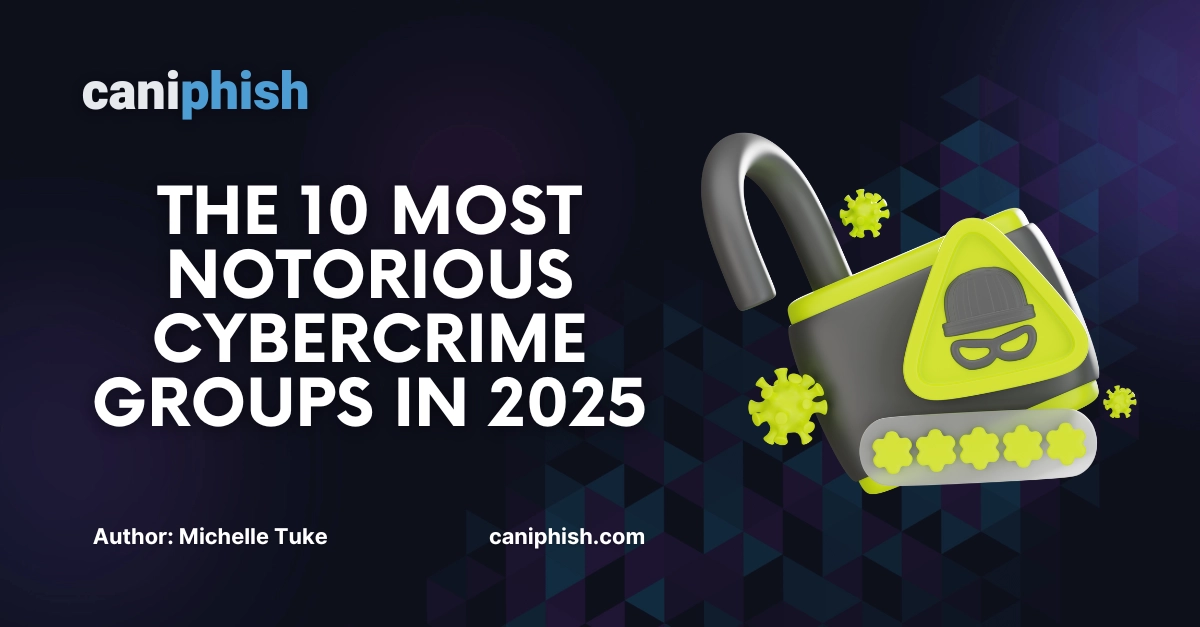
Looking to discover the most notorious cybercrime groups in 2025?
In this blog, we're counting down the 10 most feared and infamous cybercrime groups that didn't just make headlines. They made history. Some steal secrets. Some steal millions. Others just want to watch the internet burn. They all have one thing in common. They've earned a spot on the most-wanted list of 2025.
Let's dive in.
10. Conti
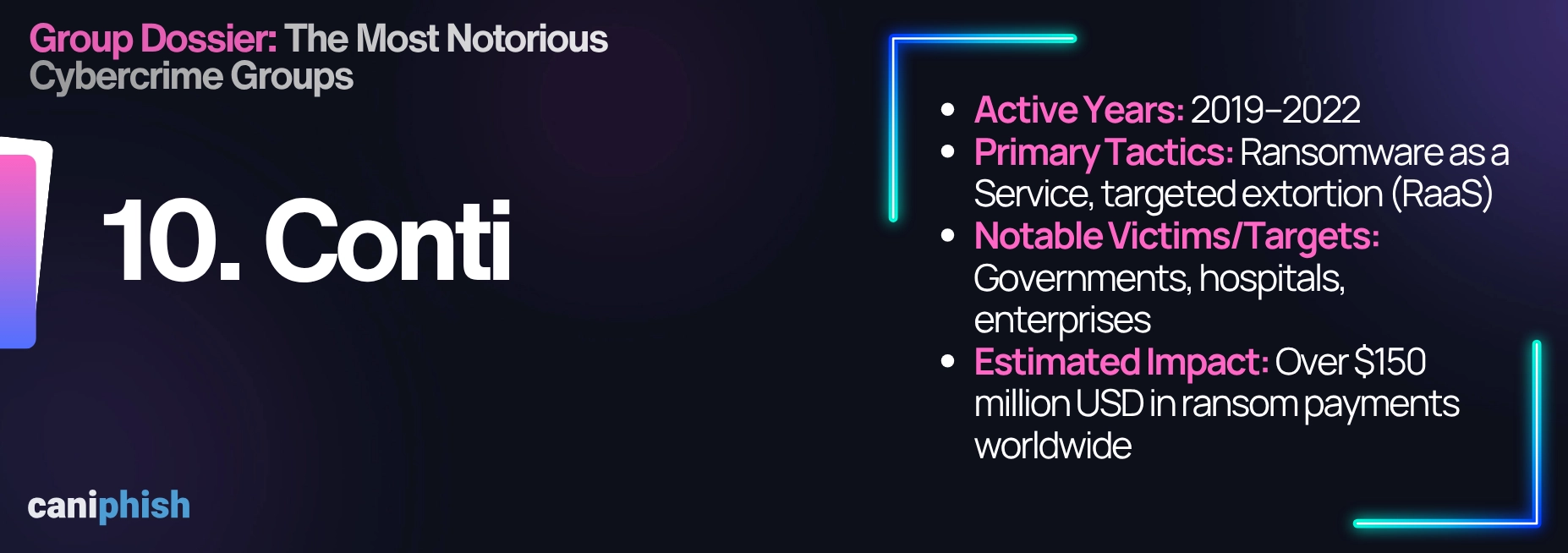
Kicking things off is the cyber gang known as Conti. This group emerged in late 2019, and they hit the ground running as a Ransom-as-a-Service (RaaS) operation.
Conti didn't waste time climbing the ranks. They built one of the most professionalized RaaS operations the world had seen. We're talking performance reviews, salary structures, internal chat logs, even HR disputes (seriously). They offered tech support to affiliates and documented their attack playbooks better than some IT teams.
They became known for hitting governments, hospitals, and global businesses with industrial-strength ransomware and demanding tens of millions in crypto.
Then, in 2022, they made one big and unforgettable mistake. They publicly pledged loyalty to Russia during the Ukraine invasion. One of their insiders leaked 60,000 internal documents about the entire operation. This included arguments, payroll, drama, and operational play-by-plays.
By late 2022, the group imploded under pressure.
But in 2025, former Conti operators are still out there, spotted in spin-offs, affiliate crews, and other ransomware groups wearing new names but running the same dirty playbook.
9. LockBit
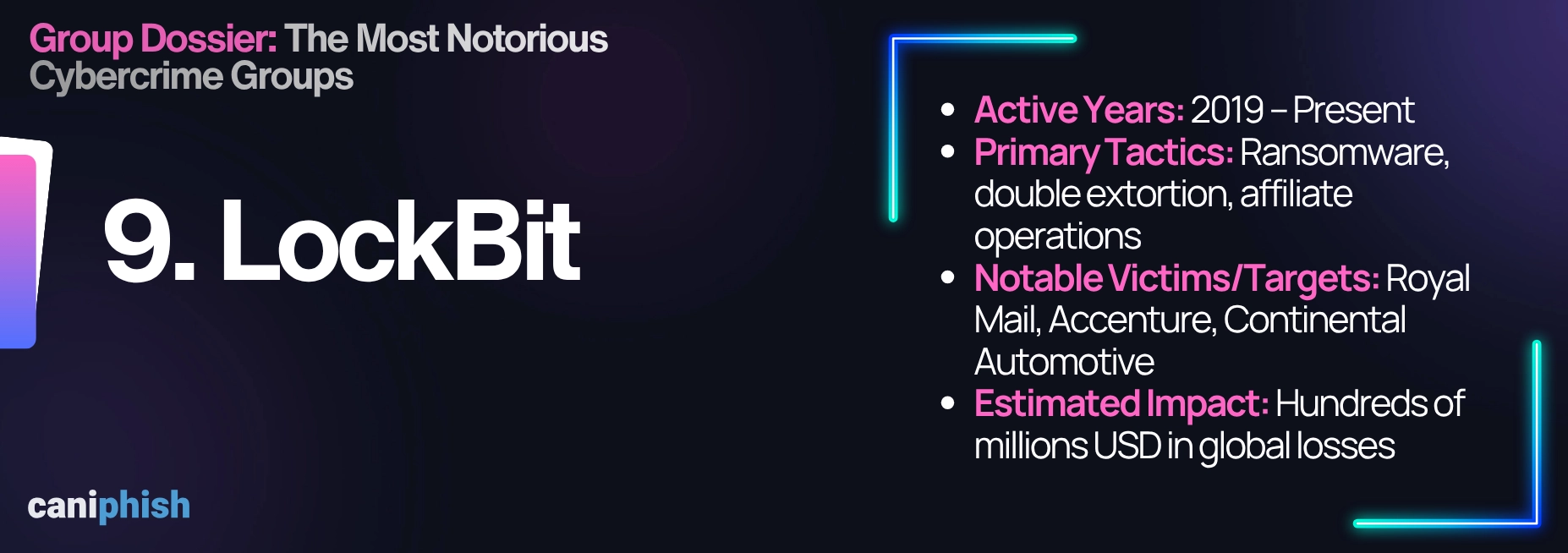
LockBit made a grand entrance in 2019, quickly earning a reputation as one of the most polished ransomware operations the cybercrime world had ever seen. They weren't just hackers. They were entrepreneurs of extortion.
LockBit gave even the least tech‑savvy criminal everything they needed to launch a ransomware attack.
Anyone with a grudge, a keyboard, and a craving for stolen crypto could join the fun. They provided the software, the infrastructure, and even a dark‑web "help desk" to guide affiliates through the process, like customer support for criminals.
Despite being hacked, humiliated, publicly exposed, and taken down by law enforcement, LockBit always managed to claw its way back. Every time the lights went out, they reappeared with a new version, a new plan, and a bigger attitude.
In 2023, LockBit hit the UK's Royal Mail, halting international deliveries and causing nationwide disruption. It was one of the most high-profile ransomware attacks on critical infrastructure, showing just how far LockBit was willing to go.
Just like every great Marvel villain, LockBit never really dies… they just come back with a darker suit and a better plan.
8. Anonymous
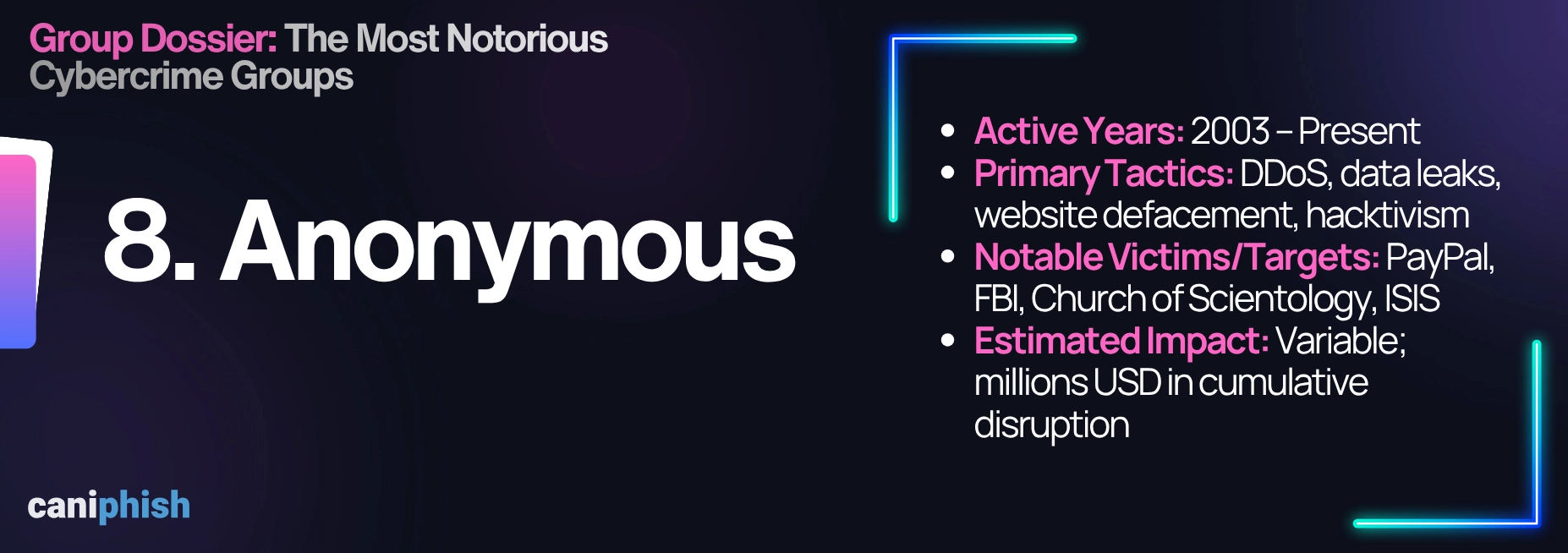
Anonymous first made noise in the 2000s, with typical, juvenile stunts like crashing websites, pranking, and trolling. The novelty wore off quickly, and they started targeting bigger targets like PayPal, governments, intelligence agencies, the Church of Scientology, and even ISIS.
What makes them dangerous is their unpredictability. One minute, they're launching distributed denial-of-service (DDoS) campaigns and leaking sensitive data, then the next, they're downing websites in the name of free speech. Next, they're declaring cyberwar on Russia after the Ukraine invasion in February 2022.
Their most notorious hack was in 2011, the takedown of HBGary Federal. Anonymous hacked into their servers, deleted data, defaced their website, and leaked tens of thousands of private emails.
What makes Anonymous notorious in 2025 is that they're still active and still fighting whatever power they decide is doing wrong.
Unlike most cybercrime groups, they don't want your crypto, they want your secrets exposed, your censorship burned, and your internet cleaned up (by fire, if necessary). They're a digital revolution armed with a meme folder and a vengeance.
7. LulzSec
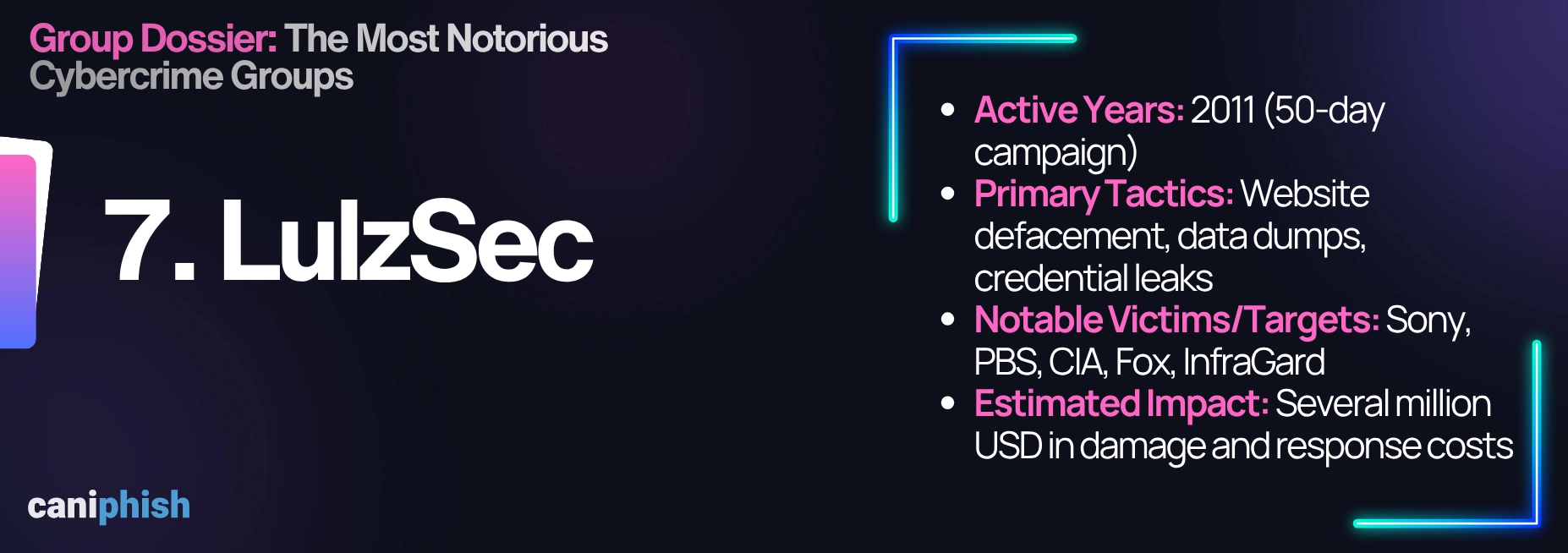
Now, although LulzSec isn't active anymore, they definitely earned their place on this list. They were only around for 50 days straight in 2011 before calling it quits, but in that short window, they managed to shake up the cybersecurity world in a big way.
Before ransomware gangs were raking in millions, LulzSec (short for Lulz Security) was hacking not for profit, but for the laughs, the spectacle, and the digital middle finger to anyone who took themselves too seriously.
During their 50-day rampage, they hacked Sony, PBS, Fox, the CIA's public website, and even the FBI's InfraGard network. They dumped credentials, defaced websites, and posted mocking press releases signed off with ASCII art, like it was a punk rock show in cyberspace.
Their calling card? Hack someone, tell the world exactly who they hit and why, then roast the victims on Twitter for having weak security.
Even though most of the crew got caught, the legacy lives on. LulzSec proved that a handful of clever, reckless, anonymous teens could embarrass some of the biggest institutions on earth, not for money, but just for the lulz.
6. Sandworm
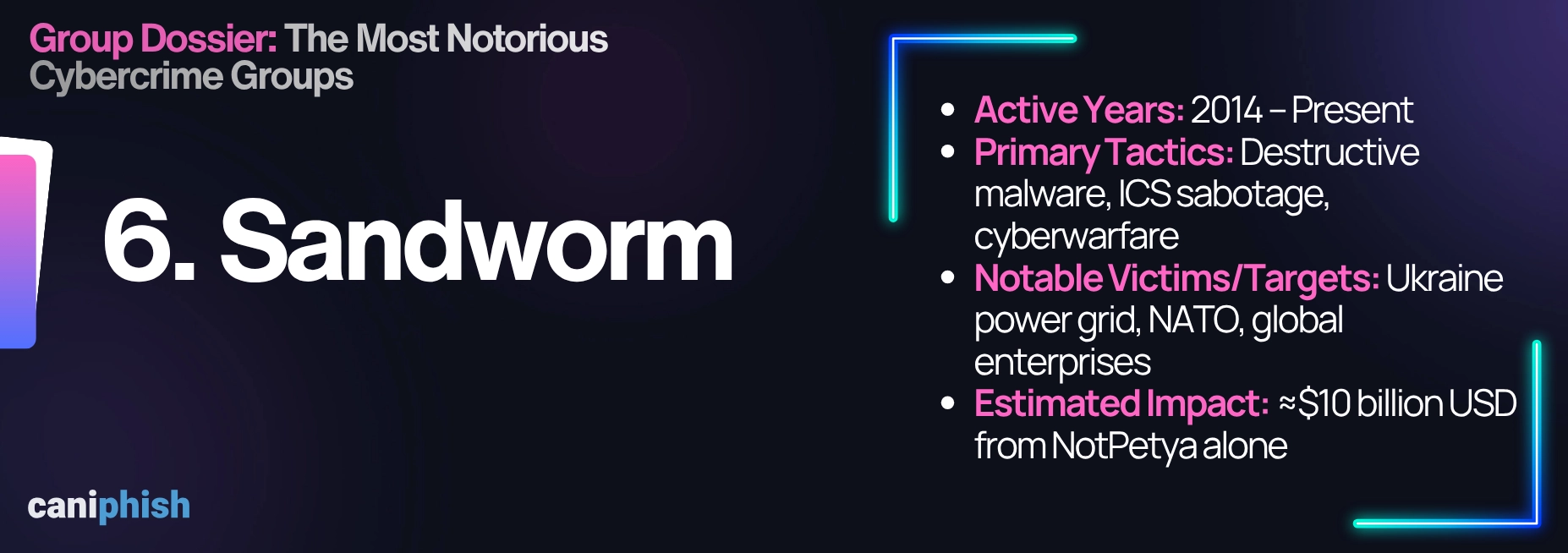
Allegedly tied to Russia's GRU (military intelligence), Sandworm is the kind of hacking unit that doesn't bother with ransom notes. No demands, no negotiations, just pure digital mayhem. These guys don't show up to steal. They show up to break things.
They specialize in cyberwarfare, not cybercrime. They've been linked to the most destructive cyberattacks in history, starting with the takedown of Ukraine's power grid (twice), and the launch of NotPetya in 2017, a wiper worm disguised as ransomware that irreversibly encrypted data globally and caused an estimated $10 billion USD in damages. That's not a typo. Ten. Billion. Dollars. All in under 24 hours.
Their typical targets? Critical infrastructure, government systems, multinational corporations, and anything remotely Western-aligned. NATO, Olympic organizers, pharmaceutical giants. You name it, they've broken into it.
And now? They're evolving. Sandworm has started blending in with ransomware crews, hiding behind criminal chaos while launching attacks that blur the line between espionage, sabotage, and full-blown cyberterrorism.
Sandworm isn't here for cash. They're here to play geopolitical dodgeball with grenades.
5. Scattered Spider
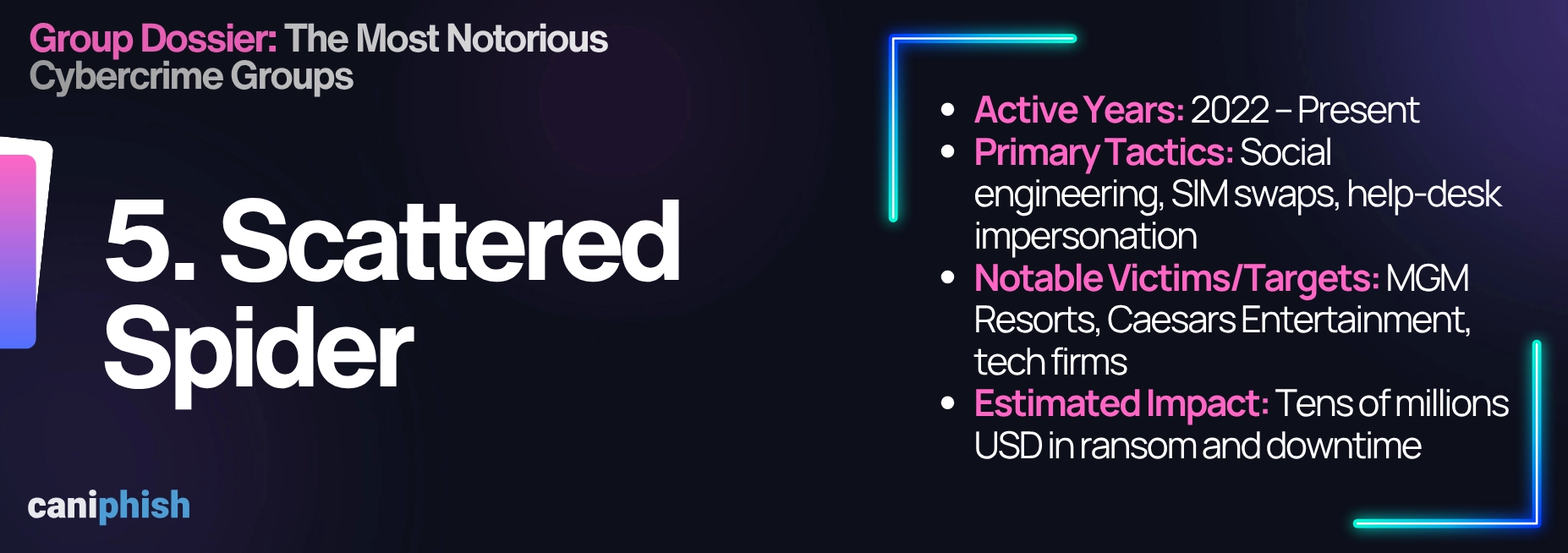
Scattered Spider isn't the typical cybercrime crew. They're young, bold, and way too confident for people who still need a fake ID to get into a nightclub. This crew burst onto the scene around 2022, and by 2025, they've gone from script-kiddie status to top-tier enterprise wreckers, taking on some of the biggest names in tech, finance, and even casinos. Yeah, casinos. They went full Ocean's Eleven… but from their bedrooms.
Scattered Spider stands out from everyone else because of its social engineering game. While other gangs go digging through firewalls and zero-days, these smooth operators talk their way in. Impersonating IT staff, tricking help desks, and SIM-swapping employees. It's like watching hackers speedrun corporate infiltration using nothing but LinkedIn and good ol' confidence.
In 2023, they targeted MGM Resorts and Caesars Entertainment, two Vegas giants. MGM had to shut down hotel systems, slot machines, booking platforms, and even key cards. Slot machines stopped working, guests couldn't get back to their rooms, and even the ATM shut shop. Talk about killing the vibe. Caesars paid millions in ransom.
Scattered Spider is still evolving, and they've proven that age doesn't matter when you know how to manipulate people better than any malware can. They're fluent in phishing, masters of manipulation, and always one step ahead of whoever's trying to shut them down.
4. Equation Group
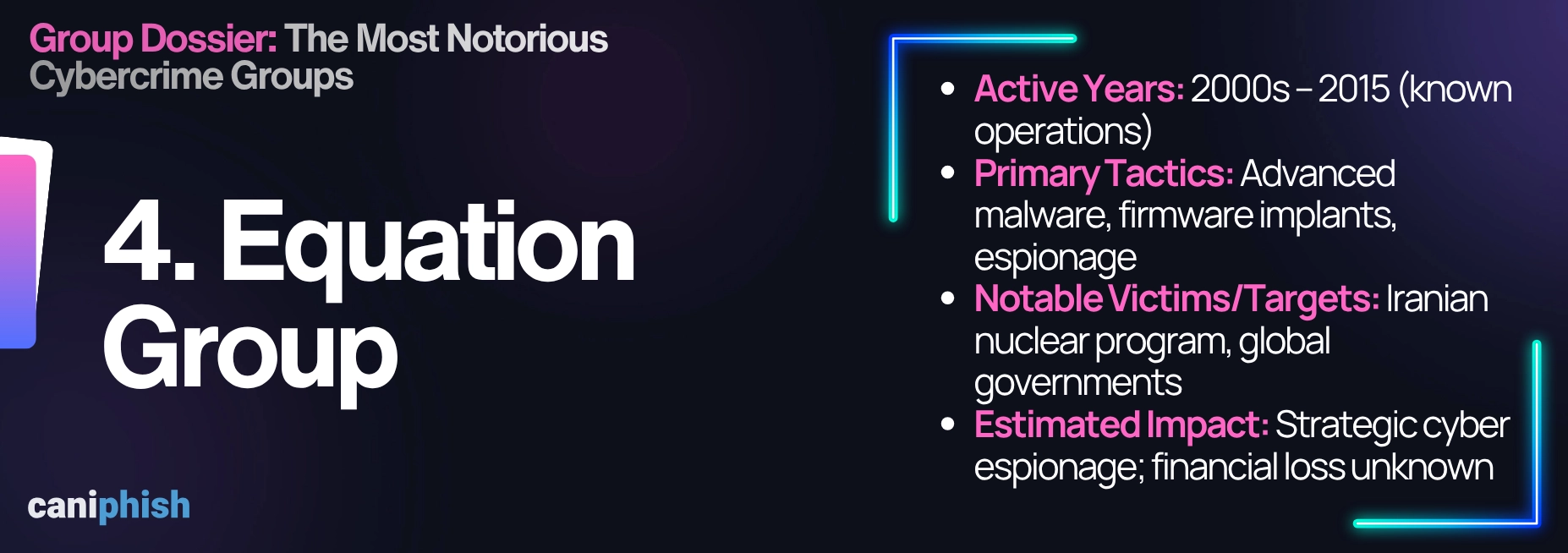
If hacking were a spy movie, Equation Group would be the elite black-ops unit lurking in the shadows, crafting custom malware in total silence while sipping lukewarm government-issued coffee.
Allegedly tied to the NSA, this crew is so advanced that they weren't even publicly named until 2015 after operating undetected for over a decade. Equation Group is widely believed to be the mastermind behind Stuxnet, the first known digital weapon to physically destroy infrastructure, specifically sabotaging Iranian nuclear centrifuges without firing a single bullet.
Their malware is the stuff of nightmares. Capable of hiding in hard drive firmware, sitting dormant for years, and even jumping air-gapped systems like it's playing cyber hopscotch.
They've been called "the most sophisticated threat actor ever seen, not in a "cool hacker" kind of way, but more of a "we should all be very, very concerned" kind of way. The Equation Group doesn't deal in ransom notes or flashy headlines. They've shaped the cyber battlefield from the top down. When their tools were leaked by the Shadow Brokers, they didn't vanish. The leaks sparked attacks like WannaCry and other global cyber disasters. Their toolkit became every hacker's greatest hits album.
3. Cozy Bear
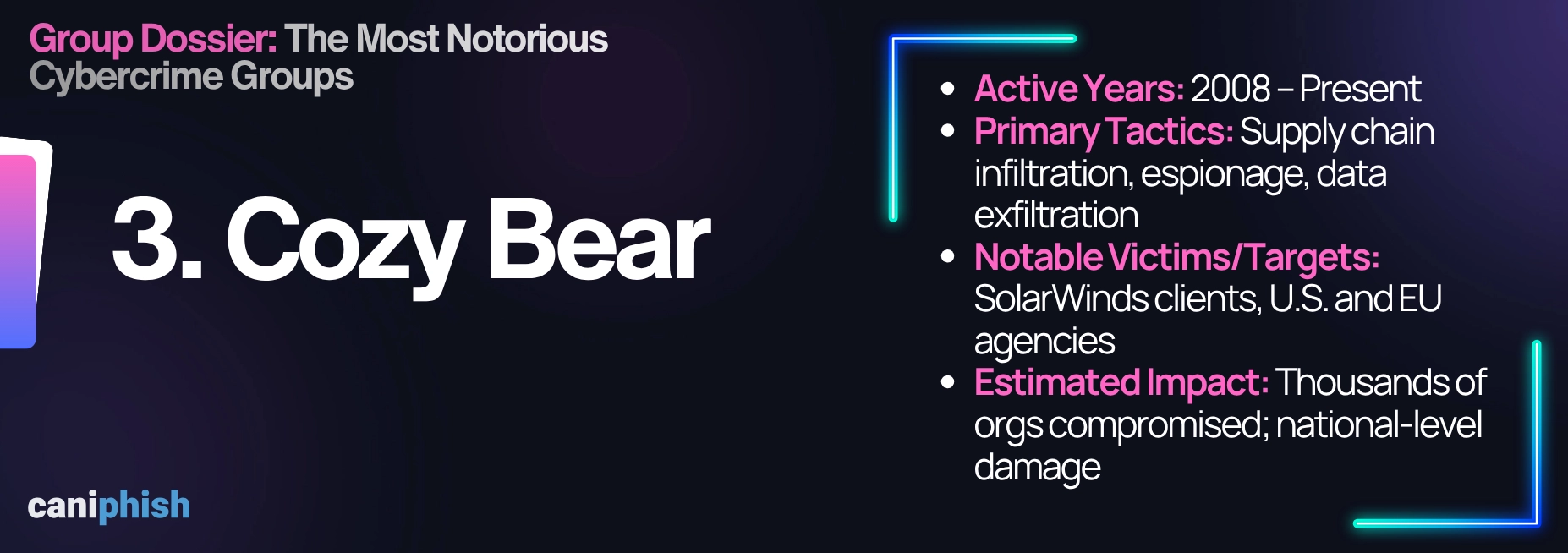
Allegedly operating under Russia's Foreign Intelligence Service (SVR), Cozy Bear doesn't do smash-and-grab. They specialize in sneak-and-snoop, long-term cyber espionage that slips under your radar and lives in your systems for months. Sometimes years.
This group has been around since at least the mid-2000s, quietly making a name for itself by spying on governments, think tanks, research institutions, and anyone with intel worth stealing.
Their most famous hit? The SolarWinds supply chain attack in 2020. Cozy Bear slipped malicious code into a trusted software update, which then infected over 18,000 organizations, including multiple US federal agencies. That's not just hacking. That's nation-state ninja stuff.
Cozy Bear is still out there. Still active. Still sticking to their strategy of patience.
While other groups chase headlines or ransom payments, Cozy Bear keeps their head down and their exfiltration tools humming.
You won't see them coming.
You won't know they've been.
And you'll probably never even know what they took.
2. Fancy Bear
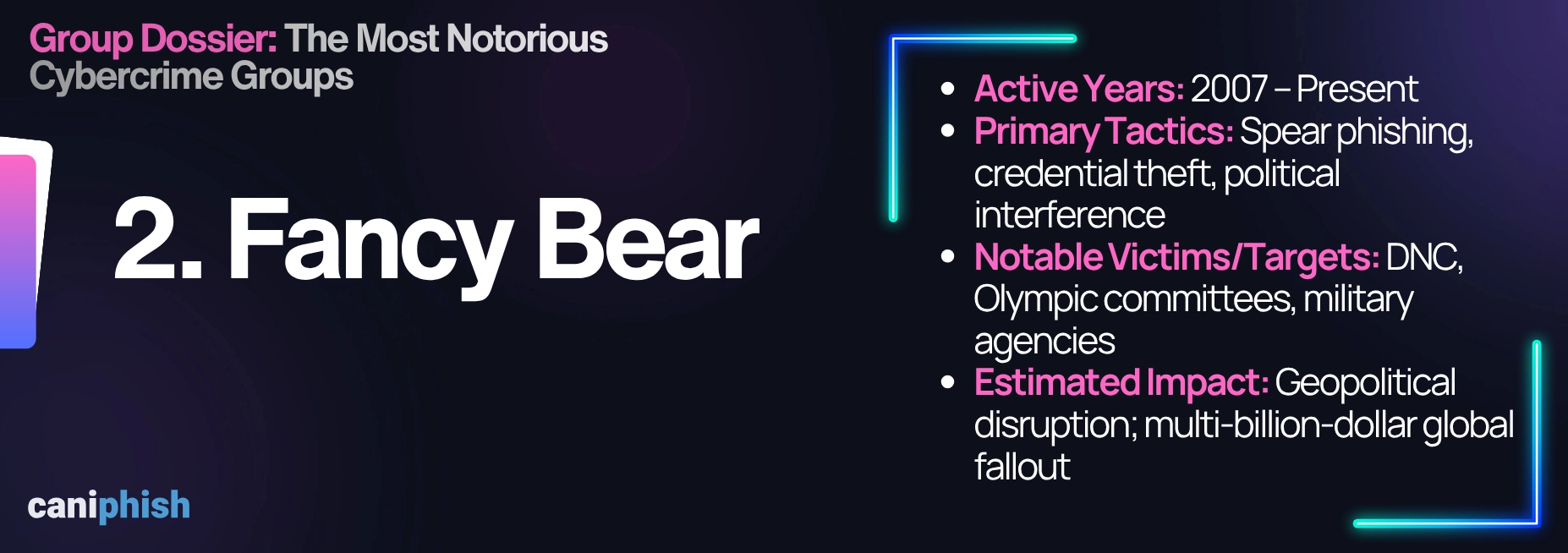
Also known as APT28, Fancy Bear is tied to Russia's GRU military intelligence, and unlike their quieter cousins (Cozy Bear), they want you to know they were there, because their hacks aren't just about stealing secrets. They're about making statements.
Fancy Bear doesn't mess around. These cybercriminals go for high-value, high-impact targets. We're talking governments, militaries, journalists, political campaigns, Olympic committees, basically anyone that might ruffle the Kremlin's fur.
They're the ones behind the 2016 US Democratic National Committee (DNC) breach, which leaked internal emails and threw a digital wrench into one of the biggest elections on the planet.
Their toolkit is nasty.
Custom malware, phishing campaigns, zero-days, credential harvesting, all backed by military precision and a whole lot of geopolitical spice. And they've kept busy. From election interference across Europe to ongoing attacks in Ukraine, Fancy Bear operates like a military unit with a PowerPoint deck full of targets and absolutely no chill.
Fancy Bear hasn't gone anywhere. If anything, they've doubled down. Hitting harder, targeting smarter, and evolving faster. They're still meddling in elections, spying on defense contractors, and messing with democratic institutions like it's their day job (because, well... it is).
1. Lazarus Group
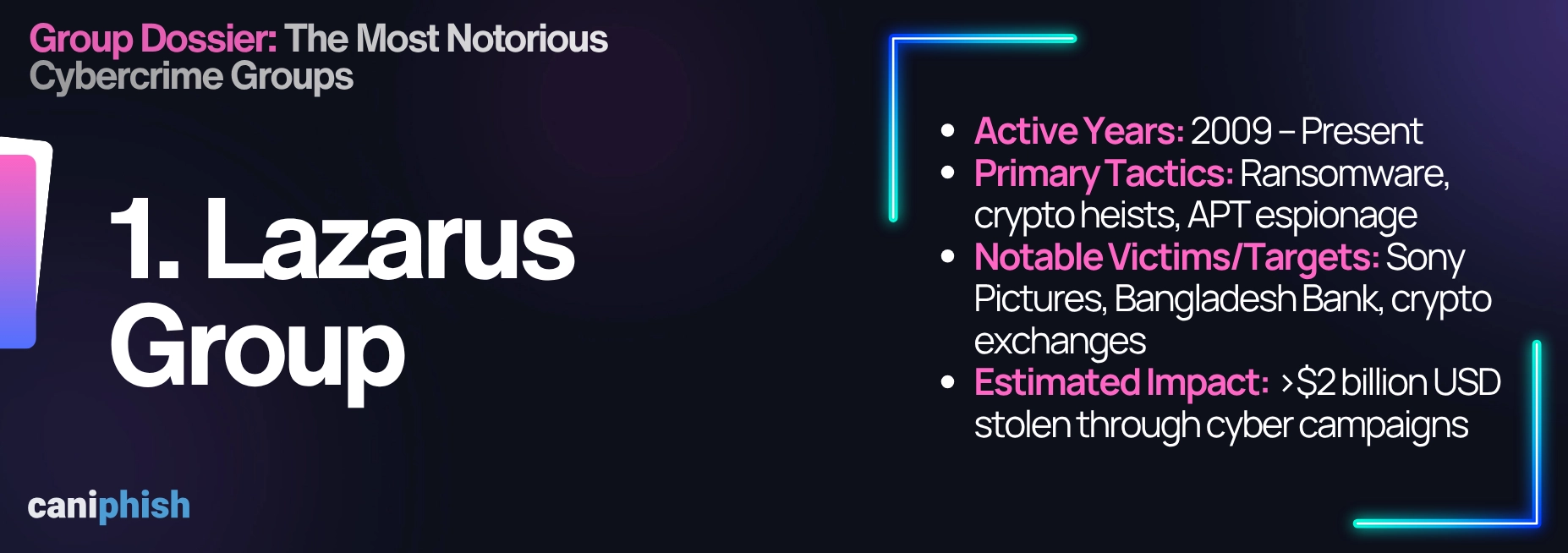
And topping the list for the most notorious cybercrime groups in 2025 is the Lazarus Group.
Backed by North Korea's Reconnaissance General Bureau, Lazarus isn't just hacking for data or disruption, they're hacking to fund a regime. And unlike most state-sponsored groups, they don't mind getting their hands very dirty.
These guys have done it all.
WannaCry in 2017? That was them. Sony Pictures hack in 2014? Also them. Banks in Bangladesh, crypto exchanges in Japan, blockchain bridges, NFT platforms, you name it, Lazarus has hit it, drained it, and vanished into the digital ether like it was just another Tuesday.
While most nation-state actors stick to spying, Lazarus runs the full criminal portfolio. Espionage? Check.
Cyber sabotage? Absolutely.
Full-scale financial theft? Oh, they've practically mastered it.
Estimates say they've stolen over $3 billion USD in crypto, much of it laundered through mixers and shady exchanges to sidestep sanctions and fund weapons programs. You read that right, they hack for nukes.
By 2025, Lazarus is still active, still dangerous, and still redefining what a cybercrime group can be. They blend nation-state discipline with underworld ruthlessness, and their attacks keep getting bolder, faster, and more profitable. They're not just a threat, they're a business model, a geopolitical weapon, and a full-blown cybercrime dynasty all rolled into one.
Lazarus Group doesn't just make the list. They own the list.
Step Into The Mind Of A Hacker
The Social Engineer is a high-stakes, turn-based cyber game where you play as an up-and-coming criminal mastermind.
Play now!Wrapping up
So there you have it!
The 10 most notorious troublemakers, all in one explosive lineup. Far from just groups of hackers. They're con artists, digital mercenaries, saboteurs, and full-blown villains playing a global game with no rulebook and no pause button.
The days of hackers poking around for bragging rights are gone.
The cybercrime groups of 2025 are running full-blown operations, some like startups, others like militaries, and a few like chaotic digital cults with a grudge against everything.
Whether they're doing it for cash, chaos, a country, or just for the hell of it, one thing's clear: the cyber underworld has gone pro.
They're well-funded, well-organized, and dangerously effective.
An Operations Analyst on a mission to make the internet safer by helping people stay a step ahead of cyber threats.
